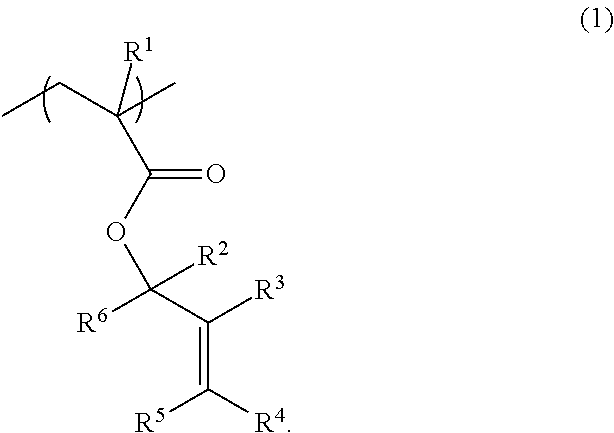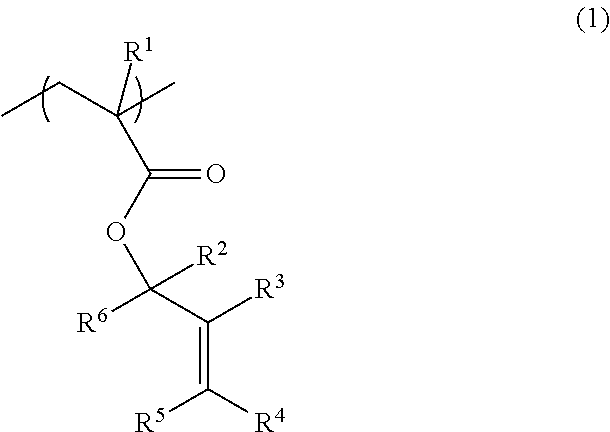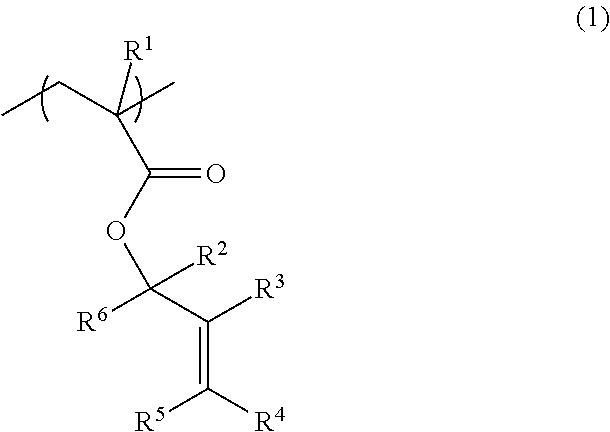Radiation-sensitive resin composition, polymer, compound, and method for producing compound
a technology of radiation-sensitive resin and composition, which is applied in the direction of photosensitive material processing, basic electric elements, electric apparatus, etc., can solve the problems of affecting the pattern-forming ability of radiation-sensitive resin composition, and difficult to obtain a good pattern-forming pattern
- Summary
- Abstract
- Description
- Claims
- Application Information
AI Technical Summary
Benefits of technology
Problems solved by technology
Method used
Image
Examples
example 1
[0269]A recovery flask (1 L) was charged with 48.1 g (500 mmol) of 2-methylenecyclopentanone and 300 mL of THF. The mixture was cooled to −78° C. using a dry ice-methanol bath. A diethyl ether solution of methyllithium (525 mmol) was slowly added dropwise to the mixture. After stirring the mixture at −78° C. for 3 hours, and at room temperature for 3 hours, a small amount of water was added to the mixture to terminate the reaction. The mixture was subjected to extraction, washing, and purification by column chromatography to obtain 43.7 g of 1-methyl-2-methylenecyclopentanol (yield: 78%).
[0270]A recovery flask (1 L) was charged with 43.4 g (387 mmol) of 1-methyl-2-methylenecyclopentanol, 58.7 g (581 mmol) of triethylamine, 1.42 g (11.6 mmol) of N,N-dimethylaminopyridine, and 500 mL of dichloromethane. The mixture was cooled to 0° C. using an ice bath. 200 mL of a dichloromethane solution of 42.5 g (406 mmol) of methacryloyl chloride was slowly added dropwise to the mixture. After st...
example 2
[0272]1-Methyl-2-methylenecyclohexan-1-ylmethacrylate represented by the following formula (M-2) was synthesized in the same manner as in Example 1, except that 2-methylenecyclohexanone was used as the starting material instead of 2-methylenecyclopentanone (total yield: 52%).
[0273]
example 3
[0274]1-Ethyl-2-methylenecyclopentan-1-yl methacrylate represented by the following formula (M-3) was synthesized in the same manner as in Example 1, except that ethyllithium was used as the reaction reagent instead of methyllithium (total yield: 49%).
[0275]
PUM
| Property | Measurement | Unit |
|---|---|---|
| temperature | aaaaa | aaaaa |
| line width roughness | aaaaa | aaaaa |
| temperature | aaaaa | aaaaa |
Abstract
Description
Claims
Application Information
 Login to View More
Login to View More - R&D
- Intellectual Property
- Life Sciences
- Materials
- Tech Scout
- Unparalleled Data Quality
- Higher Quality Content
- 60% Fewer Hallucinations
Browse by: Latest US Patents, China's latest patents, Technical Efficacy Thesaurus, Application Domain, Technology Topic, Popular Technical Reports.
© 2025 PatSnap. All rights reserved.Legal|Privacy policy|Modern Slavery Act Transparency Statement|Sitemap|About US| Contact US: help@patsnap.com



